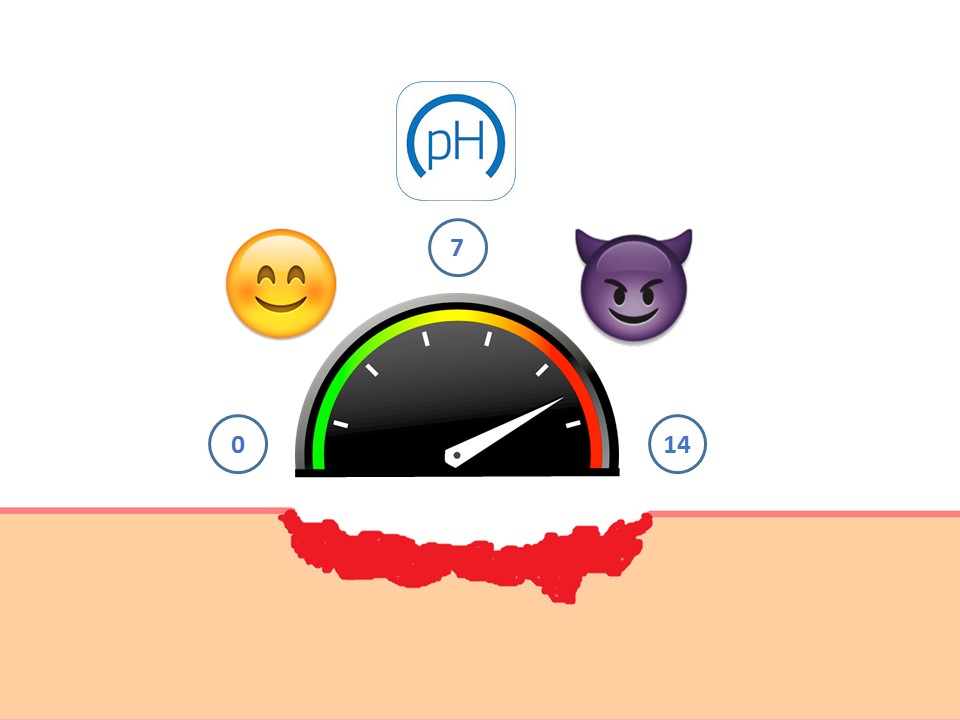Although it’s not something we think about or measure in our daily clinical practice, maintaining an adequate pH in the wound bed is essential for promoting healing. What is the optimal pH and why? Let’s find out.
What is pH?
The pH is a measure of the concentration of hydrogen ions (H+). This measurement is made on a logarithmic scale with a range of 0-14. The concentration of H+ in the different fluids of the organism is critical, as small changes in it can alter the balance of chemical reactions.
A pH of 7 is considered neutral. If the concentration of H+ increases, the pH is lower than 7 and is called acid. If the concentration decreases, the pH will be higher than 7 and will be considered basic.
In our organism there are different systems, called buffers, which stabilize the tissue pH. These include proteins, which bind and release H+ ions to maintain balance.
The skin’s natural pH is acid and its range is 4-5.5. The maintenance of this pH is essential to preserve the balance of cutaneous flora and to avoid the proliferation of pathogens. In gels, soaps and cosmetics, the term neutral pH is used to refer to the fact that its pH is close to the physiological pH of the skin, which can lead to error.
How does the pH influence wound healing?
The healing process needs to take place in a suitable microenvironment, which is influenced by different intrinsic and extrinsic factors. Among these intrinsic factors is the pH, on which depend essential functions such as:
- the release of oxygen
- angiogenesis
- protease activity
- bacterial toxicity.
Oxygen release in the tissues depends not only on perfusion, but also on diffusion. In order to promote healing of a chronic ulcer, it is essential that tissue oxygen tension (pO2) is high (>40mmHg). A pH decrease of 0.9 units can increase oxygen diffusion 5-fold.
Proteinases (see post “Metalloproteinases in chronic wounds: the problem of uncontrolled destructive activity”) are enzymes that destroy the cellular matrix and growth factors essential for healing. These enzymes have maximum activity at neutral or alkaline pH, depending on the proteinase. These enzymes are produced by the wound itself, but they are also released by bacteria found in the wound.
On the other hand, bacteria also produce ammonium from the action of urease on urea, with the consequent toxicity and alkalinisation of the microenvironment.
What is the optimal pH for healing?
Studies that have measured pH of chronic wounds have detected a range between 7.15-8.9. It has been shown that wounds with more alkaline pH have lower healing rates than wounds with a pH close to 7. When the healing process begins to progress properly, pH becomes neutral and then acidic. It is thought that the pH of the wound does not depend on the depth of the wound, but on the type of tissue that exists in the wound bed.
What is the interest of pH in our clinical practice?
Occlusion of wounds has been shown to reduce the loss of carbon dioxide (CO2), which prevents alkalosis in the wound bed. Studies have been carried out with different bioactive dressings which confirm that they lower the wound pH.
The evaluation of wound progression is currently based on subjective findings and criteria. Recording pH in the ulcer bed may represent a useful objective method for determining whether the treatment used is promoting healing.
For pH monitoring, litmus paper strips, due to their low specificity, are not a suitable method. A pH meter should be used, which is a sensor with an electrode that performs the measurement using an electrochemical method. Unfortunately, this device is not usually available in the practice.
If you want to go deeper into the subject, here is the most complete review I have found: The significance of surface pH in chronic wounds
Also available in: Español (Spanish)







